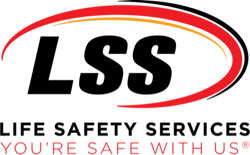
A barrier is defined as a fence or other obstacle preventing movement or access. Which in fact accurately defines the purpose and function of a fire barrier. Fire barriers are designed to contain fire and smoke within the area of origin. These walls create unique fire restrictive areas within a building or facility in efforts to provide as much time as possible for occupants to escape danger and a safe pathway in for emergency crews.
A component of compartmentalizing a facility is by installing fire barriers. As we have emphasized, compartmentalization saves lives and it’s important to ensure all fire safety features are up to date on their latest inspection deadlines and undergo routine maintenance.
According to NFPA 221 & The International Building Code (IBC) Chapter 7:
Fire Barriers are interior walls that extend from the floor‐to‐floor or floor‐to‐roof, including concealed and interstitial spaces. They are designed to sub‐divide portions of the building, and can be supported by structures, such as roofs, columns or floors. All support structures should have a fire-resistant rating no less than that of the fire barrier they support. Fire barriers restrict the initial flow of heat within the area of origin, which provides building occupants with adequate time to evacuate to safe areas. These walls will typically have a 2 to 3‐hour fire‐resistance rating.
Firewalls: What’s the difference?
Firewalls have similar function to fire barriers, both equally as important to the buildings’ fire protection system. Fire walls are thick exterior walls with a higher fire-resistance rating, while fire barriers are interior walls with a lower fire-resistance rating.
According to NFPA 221 & The International Building Code (IBC) Chapter 7:
Firewalls are exterior wall that extends continuously from the base of the building all the way to the roof. They are designed to remain standing even if the adjacent structure collapses. To do so, firewalls are built thicker than normal walls with significant structural stability under fire conditions. Sometimes buttresses or pilasters may also be required in order to provide adequate lateral stability. Firewalls will typically have a 3 to 4-hour fire-resistance rating. Adequate time to evacuate to safe areas. These walls will typically have a 2 to 3‐hour fire‐resistance rating.
The slightest hole or crack in a wall can breach the functionality of this compartmentalization component. If any damage is done or detected to the wall, no matter how big or small, that hole or crack is enough to allow fire to pass through and ultimately put the lives of those in the building at risk.
Fire Barrier Essential Reminders
As professionals in the field, we have seen it all when it comes to fire safety. Often times, penetrations can be left half fire stopped. For example, a wall penetration may only be firestop sealed on one side and not the other. If all gaps are not filled in, your fire barrier/firewall will not be beneficial to you or the occupants inside in the event of a fire.
A checklist to ensure firestopping material is properly utilized:
- Sealants
Used in combustible penetrations. (Plastic piping, multiple cables, and sleeved piping)
- Putties
Hand applied intumescent sealants. Good for hard-to-reach areas, typically limited to metal piping and cables. - Composite Sheets
Used for large openings, good for multiple penetrating item systems.
- Firestop Bricks and Plugs
Used as blocks in large and small openings.
- Spray Products
Used to increase protection over sealants. (Top of wall and perimeter fire containment systems)
Firestop materials are designed to help prevent the passing of fire and smoke through fire barriers during an active fire. As all other fire safety procedures, in order for this to work efficiently proper equipment must be utilized in the proper areas.
Over time, firestopping can start wear away due to natural causes. Once deterioration is detected, resealing the penetration must take place as this is a fire safety hazard if not taken care of. Friendly reminder to use the same manufacture firestopping product as used before. Products may not react well with one another so its important to stay consistent with one manufacturer and their UL system.
Fire Barrier Management Plans
LSS Life Safety Services® (LSS) can help you maintain your fire-rated barriers. Thus, providing a long-term solution for maintaining the integrity of your fire safety system.
- Code required six year fire and smoke damper inspection
- Quarterly or annual fire door inspection
- A Quarterly or annual fire-rated wall firestop survey with minor repairs
- Quarterly or annual above ceiling inspection, including electrical items (e.g. Open junction boxes), sprinkler lines (e.g. Wires tied to sprinkler lines or missing hangers).
All reporting is available through LSS’ exclusive web-based software, LSS Site Surveyor ®. Makes for easy reporting, simplified management, and professional presentation to the Authority Having Jurisdiction (AHJ). A turn-key service provider, LSS can also provide repair services for your passive fire protection deficiencies.
Contact Us Here or call 888-675-4519

